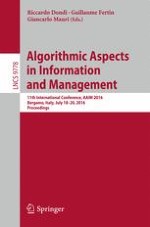2016 | Book
Algorithmic Aspects in Information and Management
11th International Conference, AAIM 2016, Bergamo, Italy, July 18-20, 2016, Proceedings
Editors: Riccardo Dondi, Guillaume Fertin, Giancarlo Mauri
Publisher: Springer International Publishing
Book Series : Lecture Notes in Computer Science
